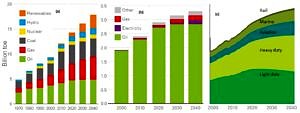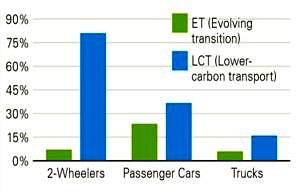Despite global efforts for renewable energy implementation and electrification of vehicles, fossil fuels still represent ~80% of global energy production [1] (79% in the EU), while CO2 emissions reached an all-time peak in 2018 [2]. The transport sector is responsible for ~21% of total energy utilisation; the heavy-duty, marine and aviation sectors represent more than 2/3rds of liquid fuel burning. Unfortunately, usage of liquid fuels is expected to increase more than 50% compared to today’s levels over the next two decades, due to the constantly increasing transport energy needs associated with the expansion of urbanisation and population growth [3]; see relevant forecasts in Figure 1.

Figure 1. (a) Primary energy utilisation and forecast till 2040. (b) Energy source and forecast for the transport sector. (c) Distribution of liquid fuel for different types of powertrains [1].
Low carbon technologies and electric vehicles (EV) are gradually becoming a reality for passenger cars, but with almost no penetration to the heavy-duty transportation sector [4] (Figure 2), where no more than 15% of the trucks fleet is expected to be electrified over the next two decades. In addition to operational factors, such as infrastructure, battery price, maintenance and reliability, penetration of plug-in EVs in the global market faces considerable technological challenges, including the design and efficiency of today’s EV Battery Thermal Management Systems (BTMS) required for its cooling. Typically, today’s BTMSs comprise air or indirect water/glycol cooling systems. Li-ion batteries have a limited temperature range of operation, i.e. 15–60 °C [5], with the optimal value lying below 40oC, while there is also a requirement for 5°C temperature non-uniformity among the cells at the pack level [6] in order to avoid further power loss and cell overheating. Typical heat production rates for current state-of-the-art batteries are in the range of 105 W/m3, while the allowed temperature rise by today’s commercial BTMSs is of the order of 30 °C. This affects BTMSs charging time and battery degradation and lifetime, hence, it constitutes a major prohibiting factor in their much-needed expansion to the transport sector.

Figure 2. (b) Forecast for electrification of vehicles by 2040, using existing battery and thermal management technologies [4].
References:
[1] BP. Energy Outlook 2019 Ed.(2019).
[2] Figueres, C. Nature 564, 27 (2018).
[3] United Nations. World Urban. Prospect. (2015).
[4] BloombergNEF. Electr. Veh. Outlook 2019 (2019).
[5] Al-Zareer, M. et al. Int. J. Energy Res. 42, 3182 (2018).
[6] Siddique, A. R. M. et al. J. Power Sources 401, 224 (2018).